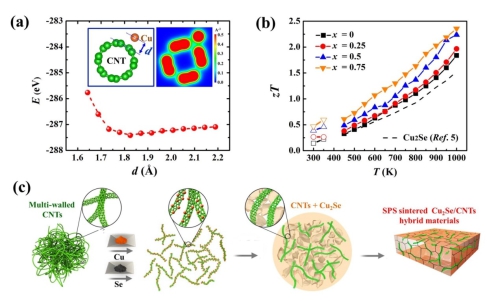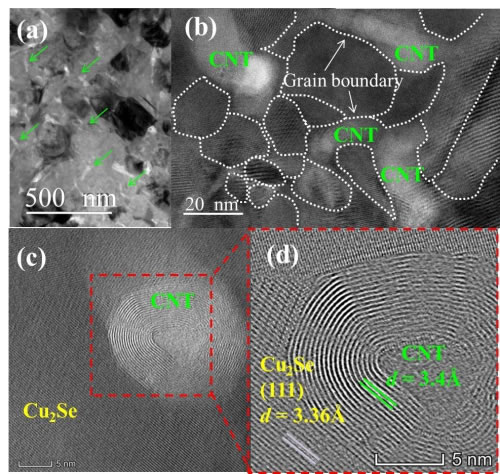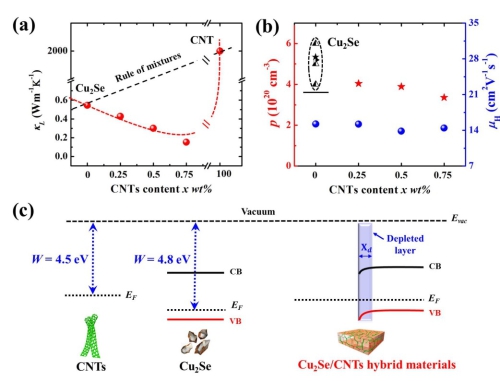(a) Chemical bonds of Cu atoms on the surface of carbon nanotubes; (b) Thermoelectric properties of Cu2Se/carbon nanotubes inorganic-organic hybrid materials and (c) Preparation process. Cu2Se/carbon nanotubes Inorganic-organic hybrid materials (a) Lattice thermal conductivity; (b) Carrier concentration and mobility; (c) Depletion layer schematic at the interface between two phases. The thermoelectric conversion technology utilizes the Seebeck effect and the Peltier effect of semiconductor materials to realize direct mutual conversion of thermal energy and electric energy, with a small system size, high reliability, no emission of pollutants, effective utilization of low-density heat, etc. Features are widely used in many fields. In recent years, research on single-phase thermoelectric materials such as skutterudite, half-Heusler, and liquid-like materials has progressed. However, due to its own crystal structure and electronic energy band structure, the performance of single-phase thermoelectric materials has almost reached or even reached its theoretical maximum. Hybrid material is a composite material composed of two different phases homogeneously mixed at the molecular or nanoscale. One of the phases of the hybrid material is an inorganic material and the other phase is an organic material. The size of the two phases of the traditional composite materials ranges from micrometers to millimeters or even larger, and the physical properties often show a simple two-phase “composite ruleâ€. Since the two phases of the hybrid material are uniformly mixed between the molecular or nanoscale, new physical properties different from the two-phase matrix are shown. At present, the hybrid materials have been deeply studied in coatings, biomedicine, construction, energy, and other fields, and there have been attempts in the field of thermoelectric materials research. However, how to achieve a uniform dispersion of the second phase, obtaining a molecular/nano-scale two-phase interface, and the new effects it brings becomes a difficult and important point in the research of hybrid thermoelectric materials. Recently, Shi Xun and Chen Lidong, researchers of the Shanghai Institute of Ceramics, Chinese Academy of Sciences, and He Jiaqing, professor of Southern University of Science and Technology, Mei-Yin Chou, professor of the Central Research Institute of Taiwan, China, and Jeff Snyder, professor of Northwestern University, used metal atoms and Chemical interactions between multi-walled carbon nanotubes and high-energy ball milling techniques were used to prepare a hybrid thermoelectric material in which carbon nanotubes were uniformly dispersed along the grain boundary of copper selenide (Cu2Se) compound, greatly increasing the thermoelectric value to 2.4. . The inorganic-organic hybrid thermoelectric material is completely different from the conventional composite thermoelectric material mixed at the millimeter to micrometer scale, exhibiting a series of new physical properties different from Cu2Se and carbon nanotubes, enriching and broadening the design of thermoelectric materials. idea. The surface of carbon nanotubes has a high chemical activity due to the presence of free electrons. The first-principle calculations found that when the metal Cu atoms are close to the surface of the carbon nanotubes, they produce a strong chemical effect. When the Cu atom is 1.83 angstroms from the center of the six-membered ring on the surface of the carbon nanotubes, the bond energy of the formed chemical bond is 0.24 eV. This allows the use of high-energy ball milling technology to mix carbon nanotubes, elemental Cu powders and elemental Se powders. A portion of the Cu atoms can be chemically adsorbed on the surface of the carbon nanotubes and react with the Se atoms to form Cu2Se nanocrystals in situ on the surface of the carbon nanotubes. Crystal, finally obtained a single carbon dioxide in the Cu2Se matrix uniformly dispersed Cu2Se/carbon nanotubes inorganic-organic hybrid materials. The new hybrid thermoelectric material composed of two kinds of carbon nanotubes and Cu2Se phase surpasses the simple two-phase “composite rule†of traditional composite materials in many physical properties. For example, the lattice thermal conductivity of carbon nanotubes in the axial direction (about 2000 W/mK) is about four orders of magnitude higher than that of Cu2Se, but the lattice thermal conductivity of Cu2Se/carbon nanotube hybrid materials is much lower than that of two-phase substrates. Only 0.2-0.4W/mK. Further studies have found that the scattering of low-frequency phonons by the two-phase interface formed by carbon nanotubes/Cu2Se on the molecular/nano scale, and the “softening†of the Cu2Se lattice by carbon nanotubes are fundamental to the low lattice thermal conductivity. the reason. In addition, due to the similar work function of carbon nanotubes and Cu2Se, the width of the charge depletion layer at the interface between the two phases is not sufficient to cause additional scattering of carriers, so the carriers of Cu2Se/CNT hybrid materials The migration rate did not appear to be significantly lower than with conventional composites. Combining these abnormal electro-thermal transport properties, Cu2Se/carbon nanotube hybrid thermoelectric materials exhibit excellent thermoelectric properties. At 1000 K, the highest thermoelectric value of zT is 2.4, which is about 30% higher than Cu2Se matrix. In addition to Cu atoms, calculations show that other metal atoms (such as Ag, Ti, Ni, Pd, Pt, etc.) also have similar chemical effects with carbon-based materials such as carbon nanotubes and graphene. Therefore, this research can be extended to other thermoelectric material systems containing the above metal elements to develop new high performance inorganic-organic hybrid thermoelectric materials. The relevant research results were published on Energy & Environmental Science and applied for Chinese invention patents. The research work has received funding and support from the National 973 Program, the National Natural Science Foundation of China, the key research projects of the Chinese Academy of Sciences, the leaders of the Shanghai Outstanding Discipline, and the Youth Innovation Promotion Association of the Chinese Academy of Sciences. LED Advertising Display,LED Display Screen,LED Advertising Screen,LED Display SHENZHEN YGHQ Optoelectronics Co.,ltd. , https://www.leds-smd.com

Microstructure of Cu2Se/Carbon Nanotubes Inorganic-Organic Hybrid Materials. 